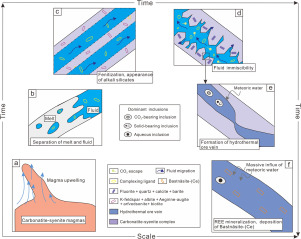当前位置:
X-MOL 学术
›
J. Geochem. Explor.
›
论文详情
Our official English website, www.x-mol.net, welcomes your feedback! (Note: you will need to create a separate account there.)
Fluid inclusions as an indicator for REE mineralization in the Lizhuang deposit, Sichuan Province, Southwest China
Journal of Geochemical Exploration ( IF 3.9 ) Pub Date : 2020-06-01 , DOI: 10.1016/j.gexplo.2020.106518 Xiaochao Shu , Yan Liu , Deliang Li
Journal of Geochemical Exploration ( IF 3.9 ) Pub Date : 2020-06-01 , DOI: 10.1016/j.gexplo.2020.106518 Xiaochao Shu , Yan Liu , Deliang Li

|
Abstract The Lizhuang rare earth element (REE) deposit in Sichuan Province, Southwest China, offers an excellent opportunity to investigate hydrothermally related REE transport and deposition in a carbonatite-related setting. Here, comprehensive fluid inclusion data combined with H O isotope systematics are presented to provide new constraints on REE mineralization in this deposit. Hydrothermal processes responsible for ore vein formation include at least two stages: (1) Pre-REE stage is marked by the deposition of gangue minerals such as fluorite, quartz, calcite and barite. Four types of fluid inclusions (i.e., aqueous, CO2-bearing, solid-bearing, and solid-CO2-bearing inclusions) are distinguished in this stage, which yield homogenization temperatures ranging from 247 to 384 °C and salinities between 4.2 and 45.3 wt% NaCl equiv. Notably, the coexistence of CO2-bearing inclusions with variable CO2 volume fractions in this stage suggests that the fluids have experienced intense immiscibility. The immiscible CO2-bearing inclusions record a pressure range of 950 to 1550 bar, assuming the temperatures varying from 300 to 340 °C. (2) REE stage is represented by the presence of abundant aqueous inclusions and minor CO2– and solid-bearing inclusions. These aqueous inclusions yield homogenization temperatures ranging from 177 to 298 °C and salinities from 0.7 to 14.4 wt% NaCl equiv. The prevalence of aqueous inclusions in bastnasite-(Ce), as well as the scarcity of CO2-bearing inclusions, indicates that REEs were likely precipitated from low- to moderately-saline aqueous fluids containing minor amount of CO2. The initial mineralizing fluids were rich in CO2, (SO4)2−, Cl−, and F− that can potentially mobilize REE. It is clear that the fluids became more dilute and CO2-poor with decreasing temperature and pressure from pre-REE to REE stage during hydrothermal evolution. All of the available data suggest that fluid cooling and massive influx of meteoric water into the hydrothermal system were responsible for REE mineralization in the Lizhuang deposit. This information is integrated into a predictive model in which the search for potential REE mineralization should target shallower parts of the vein system.
更新日期:2020-06-01


























 京公网安备 11010802027423号
京公网安备 11010802027423号